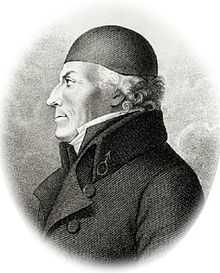Johan Gottlieb Gahn
| Johan Gottlieb Gahn | |
|---|---|
 Johan Gottlieb Gahn | |
| Born |
19 August 1745 Voxna bruk, Hälsingland |
| Died |
8 December 1818 Falun |
| Nationality | Swedish |
| Fields | Chemistry |
| Known for | Discovery of manganese |
Gahn studied in Uppsala 1762-1770 and became acquainted with chemists Torbern Bergman and Carl Wilhelm Scheele.[2] 1770 he settled in Falun, where he introduced improvements in copper smelting, and participated in building up several factories, including those for vitriol, sulfur and red paint.
He was the chemist for The Swedish Board of Mines Bergskollegium from 1773-1817. Gahn was however very reluctant to publish his scientific findings himself, but freely communicated them to Bergman and Scheele. One of Gahn's discoveries was that manganese dioxide could be reduced to manganese metal using carbon, becoming the first to isolate this element in its metal form.
In 1784, Gahn was elected a member of the Royal Swedish Academy of Sciences. He also made a managerial career in Swedish mining.
See also
- Gahnite, named after Johan Gottlieb Gahn.
References
- ↑ Weeks, Mary Elvira (1932). "The discovery of the elements: III. Some eighteenth-century metals". Journal of Chemical Education 9: 22–30. doi:10.1021/ed009p22.
- ↑ Nordisk Familjebok (1908): Gahn, Johan Gottlieb (Swedish)
Further reading
- "Biographical Account of Assessor John Gottlieh Gahn". Annals of Philosophy, New Series 8 (July): 1–11. 1824.
External links
- Article in Svenskt biografiskt handlexikon (Swedish)
- Eggerlz H.P., Palmstedt C. Nekrolog. Jahann Gottlieb Gahns Leben. // Jahrbuch der Chemie und Physik. - Nürnberg, 1822. P. 140.
|